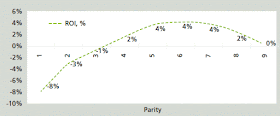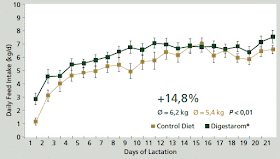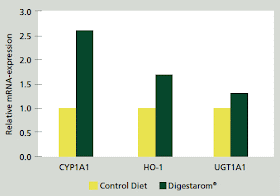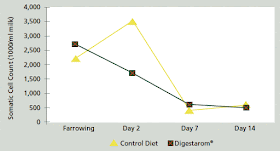By Jose Soto for Biomin
While genetic improvement has been the main driver for improved prolificacy of sows and production of high lean progeny, better nutrition offers a way for further gains.
Today’s sow produces three more pigs per litter and 40 percent heavier piglets than four decades ago. A sow needs to produce an adequate amount of milk to sustain the growth of a larger and leaner litter. Nutritional requirements of the sow are heavily influenced by phase of production and parity. Efficient sow herd management and continuous updates to the nutritional program are required to ensure high levels of sow productivity and producer profitability. Phytogenic feed additives have consistently proven to be beneficial in increasing the feed intake of sows during lactation and providing intestinal relief by preventing oxidative stress and reducing inflammatory processes.
Economics of sow retention and lactation feed intake
Targeting 70 percent retention of the gilts entering the reproductive pool and retaining them in the herd through at least the fourth parity will optimise profitability. Sow margins are optimised later in life when reaching the highest return on investment (ROI) between the fourth and seventh parity (Figure 1). However, on many commercial units 40 percent to 50 percent of sows are culled before reaching their third or fourth parity.
Sow retention is influenced by multiple factors, including genetics, nutritional programs, gilt development and health status. From a nutritional perspective, suboptimal intake of amino acids and/ or energy during lactation have been associated with prolonged wean-to-estrus interval, subsequently reduced litter sise and lighter litter weights at weaning along with lower retention rates.
Research suggests that if a sow consumes ≤ 3.5kg of feed per day during the first two weeks of lactation, it is likely to be removed from the herd prior to the next parity. Insufficient feed intake during lactation becomes critical especially for younger parity sows when nutrients are prioritised for milk production and maintenance, reducing nutrients available for reproduction.
Phytogenics have a positive impact on voluntary feed intake during lactation. Furthermore, there is evidence that phytogenics have a stabilising effect on digestion, resulting in improved feed conversion. The data presented in Figure 2 were obtained from a trial in the United States. Sows were fed a basal diet either with or without Digestarom®, a phytogenic feed additive. Sows fed Digestarom® consistently ingested more feed when compared to Control (P<0.01). Total feed intake over the period was 6.2kg, more than 14 percent higher than the control at 5.4kg.
While genetic improvement has been the main driver for improved prolificacy of sows and production of high lean progeny, better nutrition offers a way for further gains.
Today’s sow produces three more pigs per litter and 40 percent heavier piglets than four decades ago. A sow needs to produce an adequate amount of milk to sustain the growth of a larger and leaner litter. Nutritional requirements of the sow are heavily influenced by phase of production and parity. Efficient sow herd management and continuous updates to the nutritional program are required to ensure high levels of sow productivity and producer profitability. Phytogenic feed additives have consistently proven to be beneficial in increasing the feed intake of sows during lactation and providing intestinal relief by preventing oxidative stress and reducing inflammatory processes.
Economics of sow retention and lactation feed intake
Targeting 70 percent retention of the gilts entering the reproductive pool and retaining them in the herd through at least the fourth parity will optimise profitability. Sow margins are optimised later in life when reaching the highest return on investment (ROI) between the fourth and seventh parity (Figure 1). However, on many commercial units 40 percent to 50 percent of sows are culled before reaching their third or fourth parity.
 |
| Figure 1. Impact of sow retention on return on investment. Source: Adapted from Pinilla and Lecznieski, 2010 |
Sow retention is influenced by multiple factors, including genetics, nutritional programs, gilt development and health status. From a nutritional perspective, suboptimal intake of amino acids and/ or energy during lactation have been associated with prolonged wean-to-estrus interval, subsequently reduced litter sise and lighter litter weights at weaning along with lower retention rates.
Research suggests that if a sow consumes ≤ 3.5kg of feed per day during the first two weeks of lactation, it is likely to be removed from the herd prior to the next parity. Insufficient feed intake during lactation becomes critical especially for younger parity sows when nutrients are prioritised for milk production and maintenance, reducing nutrients available for reproduction.
Phytogenics have a positive impact on voluntary feed intake during lactation. Furthermore, there is evidence that phytogenics have a stabilising effect on digestion, resulting in improved feed conversion. The data presented in Figure 2 were obtained from a trial in the United States. Sows were fed a basal diet either with or without Digestarom®, a phytogenic feed additive. Sows fed Digestarom® consistently ingested more feed when compared to Control (P<0.01). Total feed intake over the period was 6.2kg, more than 14 percent higher than the control at 5.4kg.
 |
Figure 2. Effects of dietary inclusion of Digestarom® on lactation feed intake for multiparous sows. Source: Gorman et al., 2005. Texas A&M University
|
Oxidative stress on sow and fetus
Current nutritional recommendations suggest that sows might benefit from a two-phase feeding program due to higher amino acid requirement during late gestation, based on dramatic changes in fetal tissue gain. However current gestation feeding programs use only a single diet, regardless of gestation phase and parity. This does not provide enough nutrients during late gestation for fetal and mammary growth, causing catabolic conditions in sows.
New housing systems, retrofitted on new facilities can be designed to accommodate multiple phases feeding options. However, with the existing gestation facilities in many farms in the USA, feeding two gestation diets is impractical.
Catabolic conditions increase the production of reactive oxygen species, causing oxidative stress which is related to decreased availability of antioxidants during late gestation and lactation. Oxidative stress then begins to normalise towards the end of lactational period.
Oxidative damage is a strong indicator of health status and well-being of animals in relation to aging, stress, nutritional status and disease. Increased oxidative stress is responsible for a reduction in milk production, reproductive performance and eventually the longevity of sows.
During gestation, there is high energy demand and an increased oxygen requirement, which also leads to oxidative stress characterised by the placental production of reactive oxygen species including superoxide and hydrogen peroxide. Excessive free radical production may cause both lipid and protein oxidation and impair normal endothelial cell function. The elevated oxidative stress could alter placenta and fetal skeletal formation as well.
Power of plants
Phytogenic feed additives offer a pronounced antioxidative capacity. The antioxidative properties of some phytogenic substances have been attributed to the phenolic terpenes in their essential oils. An important cellular element is the transcription factor Nrf2 system, one of the major cellular defense mechanism against oxidative and xenobiotic stresses in the intestinal tract. Activation of the Nrf2 pathway leads to the induction of genes responsible for cellular defense against reactive oxygen species and detoxification.
In vitro evaluations of Digestarom® were found to upregulate Nrf2 target genes in comparison to the Control (P<0.05) (Figure 3).
Reduced inflammation and gut protection
Regular supplementation of phytogenic feed additives improves performance, not only by upregulating the transcription factor Nrf2 but also by acting as a prophylactic against inflammatory reactions in the gastrointestinal tract by down-regulating the NF-kB factor.
Digestarom® significantly reduced the mRNA levels of the NF-kB target genes IL-8, ICAM-1 and MCP-1, which initiate and maintain inflammatory reactions stimulated by antigens. To improve the performance of pig through higher feed intake and feed efficiency, subclinical inflammatory processes need to be reduced in order to increase the availability of energy and nutrients for performance rather than defense mechanism.
Lower somatic cell counts
Digestarom® decreased the gene expression of the transcription factor NF-kB and the apoptotic marker TNFα significantly in ileum and jejunum, respectively during in vivo evaluation by Kroismayr et al., (2008) suggesting an improved zootechnical performance. The data presented in Figure 4 were obtained from a trial in Slovakia. Sows were fed a basal diet either with or without Digestarom®, a phytogenic feed additive. Sows fed Digestarom® showed a lower somatic cell count compared with the control treatment.
Conclusion
An increasing number of reports have confirmed that supplementation of swine diets with phytogenic feed additives resulted in improved performance and animal health parameters. Supplementation of diets with phytogenic feed additives increases voluntary feed intake during lactation and preventing intestinal stress by providing a pronounced antioxidative capacity and modulating inflammatory processes.
Phytogenics have proven to be highly effective in improving sow nutrition and assuring producer profitability.
Visit the Biomin site HERE.
New housing systems, retrofitted on new facilities can be designed to accommodate multiple phases feeding options. However, with the existing gestation facilities in many farms in the USA, feeding two gestation diets is impractical.
Catabolic conditions increase the production of reactive oxygen species, causing oxidative stress which is related to decreased availability of antioxidants during late gestation and lactation. Oxidative stress then begins to normalise towards the end of lactational period.
Oxidative damage is a strong indicator of health status and well-being of animals in relation to aging, stress, nutritional status and disease. Increased oxidative stress is responsible for a reduction in milk production, reproductive performance and eventually the longevity of sows.
During gestation, there is high energy demand and an increased oxygen requirement, which also leads to oxidative stress characterised by the placental production of reactive oxygen species including superoxide and hydrogen peroxide. Excessive free radical production may cause both lipid and protein oxidation and impair normal endothelial cell function. The elevated oxidative stress could alter placenta and fetal skeletal formation as well.
Power of plants
Phytogenic feed additives offer a pronounced antioxidative capacity. The antioxidative properties of some phytogenic substances have been attributed to the phenolic terpenes in their essential oils. An important cellular element is the transcription factor Nrf2 system, one of the major cellular defense mechanism against oxidative and xenobiotic stresses in the intestinal tract. Activation of the Nrf2 pathway leads to the induction of genes responsible for cellular defense against reactive oxygen species and detoxification.
In vitro evaluations of Digestarom® were found to upregulate Nrf2 target genes in comparison to the Control (P<0.05) (Figure 3).
 |
| Figure 3. Up-regulation of Nrf2 target genes. Source: Gessner et al., 2013 |
Regular supplementation of phytogenic feed additives improves performance, not only by upregulating the transcription factor Nrf2 but also by acting as a prophylactic against inflammatory reactions in the gastrointestinal tract by down-regulating the NF-kB factor.
Digestarom® significantly reduced the mRNA levels of the NF-kB target genes IL-8, ICAM-1 and MCP-1, which initiate and maintain inflammatory reactions stimulated by antigens. To improve the performance of pig through higher feed intake and feed efficiency, subclinical inflammatory processes need to be reduced in order to increase the availability of energy and nutrients for performance rather than defense mechanism.
Lower somatic cell counts
Digestarom® decreased the gene expression of the transcription factor NF-kB and the apoptotic marker TNFα significantly in ileum and jejunum, respectively during in vivo evaluation by Kroismayr et al., (2008) suggesting an improved zootechnical performance. The data presented in Figure 4 were obtained from a trial in Slovakia. Sows were fed a basal diet either with or without Digestarom®, a phytogenic feed additive. Sows fed Digestarom® showed a lower somatic cell count compared with the control treatment.
 |
| Figure 4. Effects of dietary inclusion of Digestarom® on somatic cell counts for multiparous sows. Source: BIOMIN, 2008 |
An increasing number of reports have confirmed that supplementation of swine diets with phytogenic feed additives resulted in improved performance and animal health parameters. Supplementation of diets with phytogenic feed additives increases voluntary feed intake during lactation and preventing intestinal stress by providing a pronounced antioxidative capacity and modulating inflammatory processes.
Phytogenics have proven to be highly effective in improving sow nutrition and assuring producer profitability.
Visit the Biomin site HERE.
The Global Miller
This blog is maintained by The Global Miller staff and is supported by the magazine GFMT
which is published by Perendale Publishers Limited.
For additional daily news from milling around the world: global-milling.com

No comments:
Post a Comment